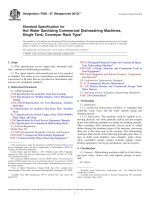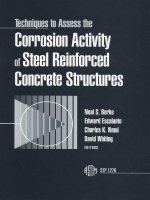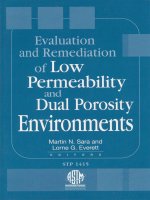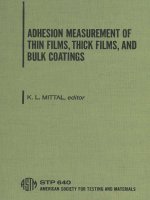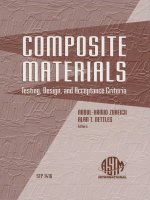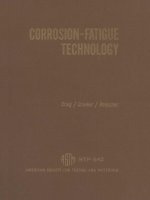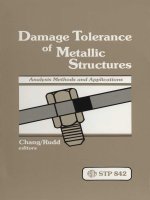Astm stp 858 1985
Bạn đang xem bản rút gọn của tài liệu. Xem và tải ngay bản đầy đủ của tài liệu tại đây (2.78 MB, 192 trang )
TEMPERATURE EFFECTS
ON CONCRETE
A symposium
sponsored by
ASTM Committee C-9
on Concrete and
Concrete Aggregates
Kansas City, IVIO, 21 June 1983
ASTIVI SPECIAL TECHNICAL PUBLICATION 858
Tarun R. Naik, University of Wisconsin
editor
ASTM Publication Code Number (PCN)
04-858000-07
€\>
1916 Race Street, Ptiiladelphia, PA 19103
Copyright by ASTM Int'l (all rights reserved); Wed Dec 23 18:20:22 EST 2015
Downloaded/printed by
University of Washington (University of Washington) pursuant to License Agreement. No further reproductions authorized.
Libraty of Congress Cataloging in Publication Data
Temperature effects on concrete.
(ASTM special technical publication; 858)
Papers presented at the Symposium on Temperature
Effects on Concrete.
"ASTM publication code number (PCN) 04-858000-07.'
Includes bibliographies and index.
1. Concrete—Thermal properties—Congresses.
I. Naik, Tarun R. II. American Society for Testing and
Materials. Committee C-9 on Concrete and Concrete
Aggregates. III. Symposium on Temperature Effects on
Concrete (1983: Kansas City, Mo.) IV. Series.
TA440.T4
1985
620.1'361
84-70335
ISBN 0-8031-0435-9
Copyright © by A M E R I C A N SOCIETY FOR T E S T I N G AND MATERIALS
1985
Library of Congress Catalog Card Number: 84-70335
NOTE
The Society is not responsible, as a body,
for the statements and opinions
advanced in this publication.
Printed in Baltimore, MD (b)
June 1985
Copyright by ASTM Int'l (all rights reserved); Wed Dec 23 18:20:22 EST 2015
Downloaded/printed by
University of Washington (University of Washington) pursuant to License Agreement. No further reproductions authorized.
Foreword
The symposium on Temperature Effects on Concrete was held in Kansas
City, Missouri, on 21 June 1983. The event was sponsored by ASTM Committee C-9 on Concrete and Concrete Aggregates. Tarun R. Naik, of the University of Wisconsin at Milwaukee, presided as chairman of the symposium and
also served as editor of this publication.
Copyright by ASTM Int'l (all rights reserved); Wed Dec 23 18:20:22 EST 2015
Downloaded/printed by
University of Washington (University of Washington) pursuant to License Agreement. No further reproductions authorized.
Related
ASTM Publications
Cement Standards—Evolution and Trends, STP 663 (1979), 04-663000-07
Significance of Tests and Properties of Concrete and Concrete-Making Materials, STP 169B (1978), 04-169020-07
Fineness of Cement, STP 473 (1970), 04-473000-07
Cement, Concrete, and Aggregates, ASTM journal
Copyright by ASTM Int'l (all rights reserved); Wed Dec 23 18:20:22 EST 2015
Downloaded/printed by
University of Washington (University of Washington) pursuant to License Agreement. No further reproductions authorized.
A Note of Appreciation
to Reviewers
The quality of the papers that appear in this publication reflects not only
the obvious efforts of the authors but also the unheralded, though essential,
work of the reviewers. On behalf of ASTM we acknowledge with appreciation
their dedication to high professional standards and their sacrifice of time and
effort.
ASTM Committee on Publications
Copyright by ASTM Int'l (all rights reserved); Wed Dec 23 18:20:22 EST 2015
Downloaded/printed by
University of Washington (University of Washington) pursuant to License Agreement. No further reproductions auth
ASTM Editorial Staff
Janet R. Schroeder
Kathleen A. Greene
Helen M. Hoersch
Helen P. Mahy
Allan S. Kleinberg
Susan L. Gebremedhin
Copyright by ASTM Int'l (all rights reserved); Wed Dec 23 18:20:22 EST 2015
Downloaded/printed by
University of Washington (University of Washington) pursuant to License Agreement. No further reproductions authorized.
Contents
Introduction
1
Strength Development of Concrete Cured Under Arctic Sea
Conditions—PIERRE-CLAUDE AITCIN, MOE S. CHEUNG, AND
VINAY K. SHAH
3
Static and Cyclic Behavior of Structural Lightweight Concrete at
Cryogenic Temperatures—DALE BERNER,
BEN C. GERWICK, JR., AND MILOS POLIVKA
21
Performance of Dolostone and Limestone Concretes at Sustained
High Temperatures—GEORGES G. CARETTE AND
V. MOHAN MALHOTRA
38
Effect of Temperature and Delivery Time on Concrete Proportions—
RICHARD D . G A Y N O R , RICHARD G. MEININGER, AND
TAREK S. KHAN
68
Effect of Hot Weather Conditions on the Strength Performance of
Set-Retarded Field Concrete—MARTIN MITTELACHER
88
Maturity Functions for Concrete Cured During Winter Conditions—
TARUN R. NAIK
107
Temperature Effects on Strength and Elasticity of Concrete
Containing Admixtures—KARIM W. NASSER AND
MADHUSUDAN CHAKRABORTY
118
Effect of Temperature Rise and Fall on the Strength and
Permeability of Concrete Made With and Without
Fly Ash—PHILIP L. OWENS
134
Effects of Early Heat of Hydration and Exposure to Elevated
Temperatures on Properties of Mortars and Pastes with Slag
Cement—DELLA M. ROY, ELIZABETH L. WHTIE, AND
ZENBE-E NAKAGAWA
150
The Willow Island Collapse; A Maturity Case Study—
GRANT T. HALVORSEN AND AMMANULLAH FARAHMANDNIA
168
Summary
177
Index
179
Copyright
Downloaded/printed
University
by
by
of
STP858-EB/Jun. 1985
Introduction
A symposium on Temperature Effects on Concrete, sponsored by ASTM
Committee C-9 on Concrete and Concrete Aggregates, was held in June 1983
at Kansas City, Missouri. This volume contains ten papers, eight of which
were presented at that symposium. The authors come from a variety of geographical areas, including the United States, Canada, and England.
The international aspect of this volume is reflected in the papers. The temperature effects on concrete described herein take place under conditions that
vary from Arctic environments to high-temperature exposures of 600°C.
While some of the authors have also presented findings of investigations for
more general use—namely, the usual cold and hot weather conditions—one
paper has even presented test results of concrete subjected to cryogenic temperatures.
The editor hopes and anticipates that this book will be of benefit to many
engineers and researchers interested in temperature effects on concrete. Also,
the references at the ends of the individual papers will be of benefit to readers
seeking additional information for detailed study of the subject of temperature effects on concrete.
The editor would like to take this opportunity to express his appreciation to
the reviewers of these papers for their timely reviews. He is also sincerely
grateful to Dr. Vance Dodson and Herman Protz, members of ASTM Committee C-9 and Subcommittee C09.02 on Research, for their help in organizing the symposium. The continuous and prompt help provided by the publications department of ASTM is also very much appreciated.
Tarun R. Naik
University of Wisconsin at Milwaukee, Milwaukee, WI 53201; symposium chairman
and editor.
Copyright
by
Downloaded/printed
Copyright 1985
University
of
ASTM
Int'l
by FM International
b y AS
Washington
(all
rights
reserved);
Wed
Dec
23
1
www.astm.org
(University
of
Washington)
pursuant
to
License
Pierre-Claude Aitcin, * Moe S. Cheung, ^ and Vinay K. Shah?
Strength Development of Concrete
Cured Under Arctic Sea Conditions
REFERENCE: Aitcin, P.-C, Cheung, M. S., and Shah, V. K., "Strength Development of
Concrete Cured Under Arctic Sea Conditions," Temperature Effects on Concrete. ASTM
STP 858, T. R. Naik, Ed., American Society for Testing and Materials, Philadelphia,
1985, pp. 3-20.
ABSTRACT: Two sets of experiments simulating the curing conditions of concrete caisson
constructions in the Arctic were carried out at Sherbrooke University, Province of Quebec,
Canada, and at Nanisivik, in the extreme north of Baffin Island, Canada (73° north). More
than 500 concrete specimens were tested for various ages and initial curing periods. After
they were cast, the concrete specimens were initially cured at about 4°C (39°F) for 3 to 15 h
and then immersed in seawater at 0°C (32°F) until testing. Their compressive strengths at
different ages, up to one year, and Young's modulus at 28 days were compared with those
of specimens of the same concrete and same age cured under room temperature.
These two sets of experiments have shown that if 9 h of initial curing at about 4°C (39°F)
is allowed for the concrete before immersion in seawater at 0°C (32°F), the design compressive strength of the concrete can be achieved at 56 days. The rate of development of
compressive strength during the first two weeks is slow because of the low temperature of
the curing environment.
The temperature of the fresh concrete and its water/cement ratio are the two most important parameters that determine the early strength of the concrete.
KEY WORDS; low-temperature curing, Arctic Sea, concrete caisson construction, compressive strength, Young's modulus, concrete
Engineers have been successfully using concrete in all kinds of environments. When correctly designed and proportioned for its environment, hardened concrete can last for many years. In fact, very often the most critical period in the life of concrete is when it changes from the freshly mixed state to a
hardened solid. During this time, an excess of water exists in the paste; its
freezing or too-rapid drying can cause permanent damage and may lead to
premature ruin of the concrete structure.
'Professor, Faculty of Applied Sciences, University of Sherbrooke, Sherbrooke, Quebec, Canada J1K2R1.
^Manager, Civil Engineering Research and Development, and senior marine engineer, respectively. Public Works Canada, Ottawa, Ontario, Canada KIA 0M2.
Copyright
by
Downloaded/printed
Copyright 1985
University
of
ASTM
Int'l
by FM International
b y AS
Washington
(all
rights
reserved);
Wed
Dec
23
1
www.astm.org
(University
of
Washington)
pursuant
to
License
4
TEMPERATURE EFFECTS ON CONCRETE
As more development takes place in the Arctic Sea because of the discovery
of rich mineral deposits and promising oil and gas fields, more concrete will
be used in this area. The average summer temperature in this region is only
about 4°C (39°F), and the seawater has an average summer temperature of
between - 1 ° C and 0°C (30 to 32°F).
Presently, most of the concrete marine structures erected in the Arctic are
cast in the south and then towed north under very difficult conditions, such as
the presence of icebergs, frequent fogs, and a very short navigation period. If
the site conditions permit, it would be advantageous to build these structures
close to the installation site. This may result in great savings in transportation, installation costs, and construction time.
The purpose of this paper is to report an investigation of the possibilities of
casting, curing, and obtaining good-quality concrete in the cold Arctic Sea
water environment. The paper also reports the simulation and study of the effects of current caisson construction practice, with which the concrete could
be exposed to cold seawater within 3 to 10 h after placement.
An intensive literature survey has shown that there is insufficient information about the effects on concrete strength and durability resulting from such
a construction practice. Therefore, Public Works Canada initiated two experimental studies simulating the curing conditions of concrete used in slip-formtype caisson construction in the Arctic Sea.
First Simulation
The first simulation was made at Sherbrooke University, Quebec, Canada,
with three ready-mix concrete mixes with water cement ratios by weight of
0.45, 0.50, and 0.55. The compositions of these concretes are given in Table 1.
A total of 150 cylindrical specimens, 150 by 300 mm (6 by 12 in.), and 4 beams,
150 by 150 by 900 mm (6 by 6 by 36 in.), were cast from each concrete. After
casting, these specimens were immediately placed in a cold storage room at
4°C (39°F) (Fig. 1). After 3 h of initial curing, 8 series of 3 specimens each
were immersed in 200-L barrels (55 U.S. gal) of artificial seawater placed in a
second cold storage room at 0°C (32°F) (Fig. 2). After 6, 9, 12, and 15 h of
curing at +4°C (39°F), 32 more series of 3 specimens each were immersed in
the same manner in the seawater (Table 2). The seawater was reconstituted by
dissolving 35 g of commercial deicing salt in every litre of fresh water (0.29 lb/
gal U.S.). The chemical composition of the salt is given in Table 3. A reference series cured at 20°C (68°F) in lime-saturated water was also taken.
All the specimens were unmolded 24 h after their casting and replaced in
the seawater at 0°C (32°F). At one day plus 3 h, the first set of 3 specimens in
seawater was tested in compression as well as 3 reference specimens cured at
20°C (68°F). Three specimens of each concrete were later tested at one day
plus 6 h, one day plus 9 h, one day plus 12 h, and one day plus 15 h, according
to their sequence of introduction in the seawater at 0°C (32°F).
Copyright by ASTM Int'l (all rights reserved); Wed Dec 23 18:20:22 EST 2015
Downloaded/printed by
University of Washington (University of Washington) pursuant to License Agreement. No further reproductions authorized.
AITCIN ET AL ON ARCTIC-SEA-CURED CONCRETE
TABLE 1—Composition and properties of the three concrete mixes used in the first simulation."
W/C Ratio
Water, kg/m''
Cement, kg/m''
Coarse aggregate, kg/m-'
Fine aggregate, kg/m^
Slump, mm
Air content, %
Temperature, °C
0.45
0.50
0.55
165
370
1020
810
55
4.5
16
165
340
1035
825
45
4.0
4
165
30O
1000
895
50
4.0
9
"To obtain the concrete composition in pounds per cubic yard, multiply the numbers of kilograms per cubic metre by 1.68.
FIG. 1—Concrete specimens in the initial curing period at 4°C I39°F).
Compression tests were performed at 7, 14, 28, 56, and 91 days, six months,
and one year, according to the ASTM Test for Compressive Strength of Cylindrical Concrete Specimens (C 39-83a). Modulus of rupture and Young's modulus tests were also performed at 14 and 28 days, according to the ASTM Test
for Flexural Strength of Concrete (Using Simple Beam with Center-Point
Loading) (C 293-79) and the ASTM Test for Static Modulus of Elasticity and
Poisson's Ratio of Concrete in Compression (C 469-81) standards, respectively.
The three concrete mixes were delivered by a local ready-mix producer between 26 Jan. and 4 Feb. 1982, when the outside temperature varied between
Copyright by ASTM Int'l (all rights reserved); Wed Dec 23 18:20:22 EST 2015
Downloaded/printed by
University of Washington (University of Washington) pursuant to License Agreement. No further reproductions authorized.
6
TEMPERATURE EFFECTS ON CONCRETE
FIG. 2—Curing of the concrete specimens in reconstituted seawater kept at 0°C (32°F).
TABLE 2—Testing program of the first simulation (cylinder size: 150 by 300 mm).
Initial
Number of Specimens Tested at Various Testing Ages
Total
Curing
Number of
Period at 4°C IDay 7 Days 14 Days 28 Days 56 Days 3 Months 6 Months lYear Specimens
3h
6h
9h
12 h
15 h
Reference
specimens
Young's
modulus
3
3
3
3
3
3
3
3
3
3
3
3
3
3
3
3
3
3
3
3
3
3
3
3
3
3
3
3
3
3
3
3
3
3
3
3
3
3
3
3
24
24
24
24
24
3
3
3
3
3
3
3
3
24
2
2
4
TABLE 3—Chemical composition of the salt.
Percent by weight
Na
Ca
Mg
37.5
0.5
0.02
0.02
CI
H2O
Nonsoluble
Total
58.5
58.5
1.1
97.7
Copyright by ASTM Int'l (all rights reserved); Wed Dec 23 18:20:22 EST 2015
Downloaded/printed by
University of Washington (University of Washington) pursuant to License Agreement. No further reproductions authorized.
AITCIN ET AL ON ARCTIC-SEA-CURED CONCRETE
7
-20°C (-4°F) and -4°C (25°F). During this period it was very difficult to
control the delivery temperature of the concrete. The delivery temperatures
for water/cement (W/C) ratios of 0.45, 0.50, and 0.55 were 16°C (61°F) (hot
water, heated aggregates), 4°C (39°F) (cold water, heated sand), and 9°C
(48°F) (hot water, cold aggregates), respectively.
The temperature of the concrete specimens was frequently measured using
thermocouples until the last cylinders were immersed in the artificial seawater.
The temperature of the specimens in the seawater was also measured during
the first 15 h (Fig. 3).
Compressive Strength Results
The average compressive strength results are shown in Tables 4, 5, and 6 in
megapascals and in percentages of the 28 days' compressive strength in Figs. 4,
5, and 6.
The following observations may be made from these figures and tables.
1. After 24 h of curing in the seawater at 0°C (32°F) the compressive strength
of the concrete specimens was always lower than that of the specimens cured
I5--
: 7c =0.45
"/c =0.50
"/c «0.55
Tamparatur* of tlw specimans
during the initial curing pariod
I0--
--60
--50
5--
Cold storoge room temperature
40
H
<
ac
Temperature of the specimens
cured in the sea water
liJ
UJ
a.
a.
UJ
--32
Cold storage room ten^perature
t=0
-5 --
when the concrete specimens were
introduced in the COM storage room
at 4 ° C or in the sea water
10
TIME
UJ
--20
20
IN HOURS
FIG. 3—Temperature measurements of the concrete specimens.
Copyright by ASTM Int'l (all rights reserved); Wed Dec 23 18:20:22 EST 2015
Downloaded/printed by
University of Washington (University of Washington) pursuant to License Agreement. No further reproduct
8
TEMPERATURE EFFECTS ON CONCRETE
TABLE 4—Compressive strength results, MPa (average of three specimens), for concrete
specimens with a 0.45 W/C ratio.
Age of Testing, days
Initial Curing
Period at 4°C
3h
6h
91i
12 h
15 h
Reference
specimens
1
7
14
28
56
91
180
365
2.8
6.2
7.3
9.0
11.3
26.4
30.7
31.7
31.4
32.8
35.2
40.4
40.7
40.3
38.9
37.9
43.6
46.1
44.4
43.0
31.3"
50.7
50.8
53.5
53.2
44.9
51.2
53.2
53.4
50.3
41.8
55.5
54.2
57.7
58.3
49.3
57.8
58.8
57.6
59.2
20.0
29.7
35.1
37.0
44.8
45.3
47.4
53.3
"Broken specimen.
TABLE 5—Compressive strength results, MPa (average of three specimens), for concrete
specimens with a 0.50 W/C ratio.
Age of Testing, days
Initial Curing
Period at 4°C
3h
6h
9h
12 h
15 h
Reference
specimens
1
7
14
28
56
91
180
365
1.1
1.9
3.5
5.5
6.6
19.7
20.9
22.1
24.9
25.0
23.5
26.0
27.7
29.5
29.7
31.1
33.3
35.7
36.2
36.5
28.5
34.8
38.8
39.9
41.6
36.0
39.2
44.5
44.0
46.6
42.0
40.4
48.7
47.9
47.1
44.7
12.8
27.8
31.2
36.0
39.0
41.6
43.5
48.6
47.5
49.0
49.3
under normal conditions. The lowest strengths were observed with the coldest
concrete [W/C = 0.50; 4°C (39°F)], which had the shortest initial curing
period at 4°C (39°F) (3 h). The highest strengths were observed with the richer
and hotter concrete [W/C = 0.45; 16°C (61°F)], cured for the longest period
of time at 4°C (39°F) (15 h).
2. At 7 days for the richest mix (W/C = 0.45), all the specimens cured in the
seawater had a higher compressive strength than the normally cured ones, except
for those that had been kept only 3 h at 4°C (39°F). For the two other mixes, the
compressive strength of the specimens cured in the seawater was lower than
that of the concrete specimens cured under normal conditions.
3. At 14 days, the compressive strength of the specimens of the two weaker
mbces of concrete (W/C = 0.50 and 0.55) cured in seawater was almost equal
to the compressive strength of the reference cylinders. The longer the exposure at 4°C (39°F), the stronger the concrete.
4. At 28 days, all the specimens cured in seawater with an initial 9-h curing
period at 4°C (39°F) were stronger than the reference specimens. A 25% in-
Copyright by ASTM Int'l (all rights reserved); Wed Dec 23 18:20:22 EST 2015
Downloaded/printed by
University of Washington (University of Washington) pursuant to License Agreement. No further reproductions authorized.
AITCIN ET AL ON ARCTIC-SEA-CURED CONCRETE
TABLE 6—Compressive strength results, MPa (average of three specimens), for concrete
specimens with a 0.55 W/C ratio.
Age of Testing, days
Initial Curing
Period at 4°C
3h
6h
9h
12 h
15 h
Reference
specimens
1
7
14
28
56
91
180
365
2.1
3.4
5.0
6.1
7.2
15.6
20.7
24.3
24.4
25.0
27.1
29.5
31.9
31.8
32.2
31.8
33.8
37.0
36.6
38.1
33.7
34.5
40.7
41.4
40.8
36.3
37.6
41.2
44.8
45.4
39.8
42.3
47.6
47.6
47.0
38.7
12.6
27.8
30.0
35.1
39.2
41.4
41.8
45.2
47.0
48.0
46.8
-8000
-7000
-6000
5000
4000
3000
-EOOO
1000
0
3
6
9
12
15
INITIAL CURING TIME AT 4°C(40°F)IN HOURS
FIG. 4—Influence of the curing conditions on the compressive strength at different ages.
Copyright by ASTM Int'l (all rights reserved); Wed Dec 23 18:20:22 EST 2015
Downloaded/printed by
University of Washington (University of Washington) pursuant to License Agreement. No further reproductions authorized
10
TEMPERATURE EFFECTS ON CONCRETE
7000
-6000
36.0MPa
&220psi)
5000
4000
3000
2000
1000
6
9
12
15
INITIAL CURING TIME AT 4''C(
FIG. 5—Influence of the curing conditions on the compressive strength at different ages.
crease in the compressive strength was observed for the 0.45 W/C ratio concrete that had been cured 9 h at +4°C (39°F).
5. At 56 days, 91 days, six months, and one year, similar results have been
observed. Moreover, at one year the compressive strength of all the specimens
cured in the seawater at 0°C (32°F) was higher than the 28-day compressive
strength of the reference specimens cured at room temperature.
Young's Modulus Measurements
Young's modulus values are presented in Table 7. This table illustrates that
the concrete cured in seawater always has a lower Young's modulus than the
reference concrete cured under room conditions.
In Fig. 7 the Young's modulus values have been plotted as a function of the
compressive strength of the concrete; also plotted is the theoretical curve given
Copyright by ASTM Int'l (all rights reserved); Wed Dec 23 18:20:22 EST 2015
Downloaded/printed by
University of Washington (University of Washington) pursuant to License Agreement. No further reproductions authorized.
AITCIN ET AL ON ARCTIC-SEA-CURED CONCRETE
11
MPo
""k
140--
I80d
50-
-7000
-6000
40-
C
100--/'
X
1 ^
'<=
-5000
-4000
-3000
•2000
-1000
6
9
12
15
INITIAL CURING TIME AT 4''C(40°F)IN HOURS
FIG. 6—Influence of the curing conditions on the compressive strength at different ages.
TABLE 7— Young s modulus measurements, GPa, under different W/C ratios
and curing conditions.
W/C Ratio
0.50
0.45
Tested at
14 days
Tested at
28 days
0.55
Seawater
Reference
Seawater
Reference
Seawater
Reference
26.0
32.5
23.6
31.1
27.8
31.6
27.3
35.7
25.4
35.8
28.3
34.6
Copyright by ASTM Int'l (all rights reserved); Wed Dec 23 18:20:22 EST 2015
Downloaded/printed by
University of Washington (University of Washington) pursuant to License Agreement. No further reproductions authorized.
12
TEMPERATURE EFFECTS ON CONCRETE
!sd Ni snnnaow
ONHOA
(0
I
I
I
o
o
o
o
o
o
in
ro
-Mh
oin
o
o_
o
ằ ằ
1
2
u
2
< â
Z
T
H
CO
5z
ãa
1-
'^
s
3
fr
cn
Ul
lU
>
(A
UJ
B
z
o til
>
(0
M
o
tu
£
z 8ou
in
e
o
o
to
i
s
^
•n
0
S
?f
11
i
n. o
J
I
1
I
L
I
2
od9 NI snnnaow ONnox
I
I
4AV^
o
(M
Copyright by ASTM Int'l (all rights reserved); Wed Dec 23 18:20:22 EST 2015
Downloaded/printed by
University of Washington (University of Washington) pursuant to License Agreement. No further reproductions authorized.
AITCIN ET AL ON ARCTIC-SEA-CURED CONCRETE
13
by American Concrete Institute (ACI) Standard 318-77 [1]. In this figure it
can be seen that the relationship between the compressive strength and the
Young's modulus is quite different depending on the curing conditions of the
concrete. Concrete cured in seawater at 0°C (32°F) has a lower Young's
modulus than concrete of the same compressive strength cured under standard conditions. For example, for 35 MPa compressive strength (5075 psi) the
difference is about 6 GPa (10* psi), approximately 25%.
Second Simulation
Because the results of this first simulation had shown that concrete could
gain compressive strength when cured in seawater at 0°C (32°F), a second
simulation under field conditions was carried out in August 1982 in Nanisivik,
in the extreme north of Baffin Island (Fig. 8).
Concrete specimens were cast and cured at ambient temperature for 6, 9,
and 12 h, and then were immersed in seawater according to the testing program shown in Table 8. These specimens were tested at 1, 4, and 56 days,
North Mognefic Pole
/ X OTTAWA
tJ-TORONT^
FIG. 8—Nanisivik location.
Copyright by ASTM Int'l (all rights reserved); Wed Dec 23 18:20:22 EST 2015
Downloaded/printed by
University of Washington (University of Washington) pursuant to License Agreement. No further reproductions authori
14
TEMPERATURE EFFECTS ON CONCRETE
TABLE 8—Testing program of the Nanisivik experiment.
Specimen Size
100 by 200 mm
(4 by 8 in.)
150 by 300 mm
(6 by 12 in.)
Initial Curing
at Ambient
Temperature
6h
9h
12 h
reference
specimens
6h
9h
12 h
reference
specimens
Number of Specimens Tested at
Various Testing Ages, days
1
7
28
56
Total
Number of
Specimens
3
3
3
3
3
3
3
4
3
3
4
3
12
14
12
3
3
3
3
3
3
3
3
3
3
12
6
6
6
3
3
3
3
12
-
along with a series of specimens cured at room temperature. The seawater
composition at Nanisivik is given in Table 9; it is almost the same as the seawater composition given in the handbook in Ref 2.
The concrete aggregates, a crushed stone (0 to 20 mm) and a natural sand,
had a combined grain size distribution within the limits suggested by Canadian
Standards Association (CSA) Standard A23-1 (Fig. 9) [3\. The amount of aggregates used in the mix was measured by volume because no scales were
available; a Type 1 cement was added in 40-kg (88-lb) sacks, and the amount
of water was adjusted to provide a slump of 110 to 140 mm. The exact volume
of water introduced into the mbc was measured using graduated barrels and
pails in order to know exactly the value of the W/C ratio of the concrete. No
additives were used. The approximate composition of the concrete is given in
Table 10. Its design strength was 30 MPa (4350 psi).
The concrete specimens were cast in 100 by 200-mm (4 by 8-in.) and 150 by
300-mm (6 by 12-in.) cardboard molds, on Saturday 28 Aug. 1982, at 4:30 P.M.
The ambient temperature at that time was about 5°C (41°F), and the temperature of the seawater was about 3°C (37°F).
The first series of specimens was initially cured for 6 h at ambient temperaTABLE 9—Nanisivik sea water composition.
Chemical
Elements
NaCl
MgS04
MgClj
CaCl2
KCl
Salinity
Nanisivik, g/L
Handbook Values [2]
for Seawater, g/L
25.8
3.5
1.2
0.9
0.6
32
25
4
3
1
0.7
34
Copyright by ASTM Int'l (all rights reserved); Wed Dec 23 18:20:22 EST 2015
Downloaded/printed by
University of Washington (University of Washington) pursuant to License Agreement. No further reproductions authorized.
AITCIN ET AL ON ARCTIC-SEA-CURED. CONCRETE
15
I
1
^
I
O
i
% tG SIVSIWVI
Copyright by ASTM Int'l (all rights reserved); Wed Dec 23 18:20:22 EST 2015
Downloaded/printed by
University of Washington (University of Washington) pursuant to License Agreement. No further reproductions au
16
TEMPERATURE EFFECTS ON CONCRETE
TABLE 10—Approximate concrete composition for Nanisivik program.
Component
Batching Composition
per 8 m^
Approximate Composition
per 1 m^
1180 (exact)
2240 (exact)
3 loader charges
1 loader charge
147.50 (248 lb)
280 (470 lb)
51% by weight
49% by weight
Water, L
Cement Type 10, Itg
Red stone
Yellow sand
Water/cement ratio
Air content, %
Ambient temperature, °C
0.53 (exact)
1.9% (exact)
5
ture and then placed in a special steel cage and submerged in the seawater at
10:30 P.M. The concrete was still plastic at that time. The second and third
series of specimens, with curing periods of 9 h and 12 h at ambient temperature, were placed in the seawater the next morning at 1:30 and 4:30 A.M.
respectively.
Temperature of the Concrete Specimens
The temperature of one specimen of each series was measured during the
first 24 h. These temperatures are plotted in Figs. 10, 11, 12, and 13. As can
be seen in Table 11, the ambient temperature varied between 8°C (46°F) and
-2°C (28°F) and the seawater temperature between -2°C (28°F) and 4°C
20
-
^ ^ ^
Temperature of the concrete
(indoor conditions)
y ^
- 70
- - 60
o
Room temperature
50
10
I
_
Temperature of the concrete
for the 9h series
».
^
^^^^"^^
^
a.
40
Ml
I
UJ
- 32
1
1
1
1
10
12
14
16
20
22
24
TIME IN HOURS
FIG. 10—Comparison of the temperature of the indoor cured concrete and the 9-h submerged
series during the first 24 h.
Copyright by ASTM Int'l (all rights reserved); Wed Dec 23 18:20:22 EST 2015
Downloaded/printed by
University of Washington (University of Washington) pursuant to License Agreement. No further reproductions authorized.
AITCIN ET AL ON ARCTIC-SEA-CURED CONCRETE
Curinginoif
+9
J 7
17
Curing in «ea woter
^50
^
Concrete specimens temperature during
the 6t) curing at ambient temperature
Sea vMiter
temperature
UJ
.Ambient air
temperature
Mi
a.
z
40
A*
V-
a:
Temperature of
submerged specimeris,'^
UJ
a.
UJ
z
X
I
2
4
6
32
%
Time of
submergence
8
10
12
^
a:
^
30
14
16
16
20
22
24
TIME IN HOURS
FIG. 11—Variation of the temperature of the 6-h series specimens.
Curing in teo woter
Curing in oir
50
•>tr
+9 -
Concrete specimens temperature during
tt)e9t) curing at ambient temperature
40
3
t
I
Temperature of
submerged specimens X
V,:
-Ambient air
temperature
-2 -
8
10
z
32
Sea water
temperature
Time of
submergence
12
14
16
y
^
^ ^
18
J_
20
_L
22
UJ
30
24
TIME IN HOURS
FIG. 12—Variation of the temperature of the 9-h series specimens.
(39°F), whereas the temperature of the concrete cured at room temperature,
about 15°C (59°F), rose to 25°C (77°F) after 24 h of curing.
Figure 10 shows that the induction period of the cement was about 8 h for
the specimens stored at room temperature; by that time, a strong increase in
the temperature of the concrete was noticed. A small peak in the temperature
in the 9 and 12-h concrete was also observed before their submergence in the
seawater at 0°C (32°F). Moreover Figs. 11, 12, and 13 illustrate that because
Copyright by ASTM Int'l (all rights reserved); Wed Dec 23 18:20:22 EST 2015
Downloaded/printed by
University of Washington (University of Washington) pursuant to License Agreement. No further reproductions authorized.
18
TEMPERATURE EFFECTS ON CONCRETE
Curing in oir
Curino in »eo water
^
•VN-
+9
50
Concrete specimens temperature during
ttie I2ti curing at ambient temperature Sea water
I
temperature
o
o
Z
40
^ikv'
Temperature of
submerged specimen
Time of
submergence
Ambient air
temperature I
^
Q.
A-
10
12
14
V16
UJ
a:
UJ
32
30
20
22
UJ
t-
24
TIME IN HOURS
FIG. 13—Variation of the temperature of the 12-h series specimens.
TABLE 11—Ambient temperature and seawater temperature during the first 24 h.
Time after Casting
2h,
2h,
3h,
4h,
4h,
5h,
6h,
6h,
9h,
12 h,
23 h,
Ambient Temperature, °C
Seawater Temperature, °C
30 min
45 min
10 min
00 min
45 min
30 min
00 min
45 min
00 min
15 min
00 min
of the small size of the specimens, the concrete very rapidly reached the temperature of the seawater.
Compressive Strength Results
The compressive strength results are recorded in Table 12. It shows that the
24-h compressive strength of the concrete cured in seawater was very low.
However, after four days, all of the concrete specimens cured in seawater had
reached a compressive strength of about 15 MPa (2175 psi), regardless of their
initial curing period at the ambient temperature. This is more than half the
strength of the concrete cured at room temperature.
Unfortunately, specimens could not be tested at 28 days because the steel
Copyright by ASTM Int'l (all rights reserved); Wed Dec 23 18:20:22 EST 2015
Downloaded/printed by
University of Washington (University of Washington) pursuant to License Agreement. No further reproductions authorized.
